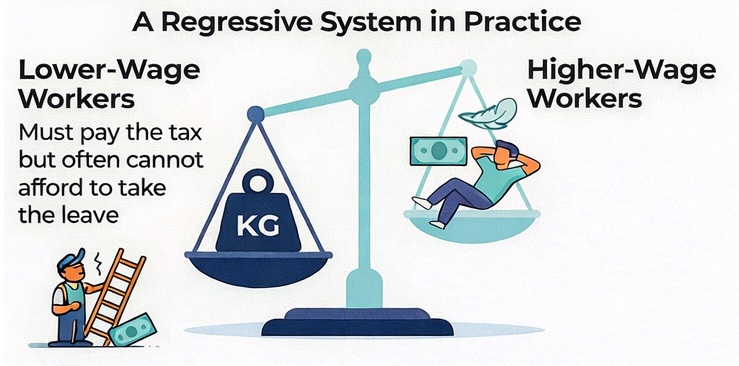Download a PDF of this Legislative Memo with citations here.
- After proposing a workers’ compensation tax increase of 1.8 percent for 2015, the state Department of Labor & Industries increased taxes by 0.8 percent; but even 0.8 percent is more than employers and workers should have to pay this year.
- The state could have cut workers’ compensation tax rates by 3.4 percent this year and kept the system financially sound; employers and workers will actually pay 4.2 percent more in workers’ compensation taxes than they need to in 2015.
- The state will take in 0.3 percent more with the lower rate increase (0.8 percent) than with the originally proposed (1.8 percent) higher rate.
- Between 2000-2015, Washington officials imposed a 70 percent workers’ compensation tax increase on workers and employers trapped in our state’s monopoly system.
- Between 2000-2015, workers’ compensation rates in neighboring Oregon decreased 26.8 percent and increased just 6.9 percent in Idaho.
- Oregon and Idaho allow private insurers to compete for business, driving workers’ compensation prices down.
- Washington state should emulate the Oregon experience, or, at the very least, control costs so long-term rate increases more closely track the modest increases in neighboring Idaho.
Introduction
Officials at the state Department of Labor and Industries (L&I) have increased the average rate for workers’ compensation taxes by 0.8 percent in 2015. This is less than the 1.8 percent increase the Inslee administration planned this fall; the agency credits better-than-expected investment returns for the smaller rate increase.
L&I officials say employers and workers should be happy to pay the smaller tax increase because it will “keep about $20 million in their pocketbooks—money they would have paid into the system under the higher proposal.” However, while in the past officials have imposed workers’ compensation tax hikes as high as 29 percent, even 0.8 percent is far more than employers and workers should have to pay this year.
Based on Washington Policy Center’s research there are three reasons why Washington state should not impose a workers’ compensation tax increase on employers and workers in 2015.
Background
The state workers’ compensation program provides injury insurance coverage for most employers and workers in Washington state. The system is managed and administered by the state Department of Labor & Industries; the director of Labor & Industries is appointed by the governor and serves at the governor’s pleasure.
Workers’ compensation insurance is mandatory and businesses must purchase coverage through the monopoly state fund run by L&I. Private workplace injury insurance is illegal in Washington. The state permits some businesses to self-insure, however, this option is reserved for only a small number of large employers. The monopoly state-run system covers 2.4 million workers and more than 160,000 employers.
Washington is one of just four states where selling private workplace injury insurance is against the law.
How the workers’ compensation program works
State officials manage all injured worker claims and pay medical, time-loss, pension, retraining and other benefits from an account called the Washington State Fund.
The Washington State Fund run by the state consists primarily of three smaller accounts: The Medical Aid Account, the Accident Account and the Pension Reserve Account.
The Pension Reserve Account is not funded by premiums. It is funded through contributions and transfers from the Accident Account and from self-insured companies. Because of the way the Pension Reserve Account is financed, its solvency is maintained as long as the accident fund and the self-insurance program remain solvent.
The Medical Aid and Accident Accounts are funded by payroll taxes paid primarily by employers and, to a lesser extent, by workers. Washington is the only state where workers may pay a portion of workers’ compensation premiums, about 25 percent of the cost. Employers have the option to pay the employee portion of premiums or deduct it from worker paychecks.
The contingency reserve is the difference between the Accident and Medical Aid Accounts’ combined total assets and total liabilities. The reserve is designed to cover unexpected losses as well as shortfalls in premium and investment income. When the contingency reserve falls below zero, the fund is insolvent because liabilities exceed the value of assets.
Annual Review
Every year, Labor and Industries officials review workers’ compensation tax rates and make adjustments to cover the cost of claims they estimate will be filed in the following year. In other words, the agency must determine the overall rate change that is necessary to adequately cover the costs of running the state-run workers’ compensation system.
The three biggest factors influencing workers’ compensation tax rate changes are workers’ wages, health-care costs and time-loss benefits. Washington is the only state that bases workers’ compensation taxes on hours worked (every other state bases workers’ compensation premiums as a percentage of payroll), so rates are adjusted annually to account for wage inflation. Washington pays the highest injured worker benefits in the nation. While total benefits are the highest in the nation, medical benefits as a percentage of total benefits paid are the lowest in the country at just over 30 percent; the national average is around 50 percent.
Another factor driving rates is the performance of the Fund’s investments. Investment income allows the state to offset some of the system’s costs, while investment losses mean higher taxes on employers and workers.
Based on these factors, the agency determines what the actuarially indicated overall rate change is for the upcoming year and, based on the indicated rate change, announces the proposed overall rate change. After a formal hearing process that includes public comment on the proposed overall rate change, the Director of L&I approves the final rate change for the following year.
The overall tax increase is an average. Individual employers may experience an increase or decrease in their actual rates, depending on their claims history and any changes in the frequency and cost of claims in their industry sector as a whole.
Three reasons workers’ compensation taxes should not have increased in 2015
Reason #1: Tax rates could be cut
According to Labor and Industries officials, the “indicated rate change” necessary to keep the workers’ compensation system sustainable in 2015 is negative 3.4 percent, (largely due to good returns from the stock market). So the agency could have cut workers’ compensation tax rates by 3.4 percent this year and kept the system financially sound. The o.8 percent rate increase the Department has imposed means employers and workers will actually pay 4.2 percent more in taxes than they need to.
If L&I officials cut the workers’ compensation tax instead of raising it, employers and workers would save more than $80 million next year, according to the agency. Even keeping workers’ compensation taxes flat would save money, while still bringing in more than enough money to keep the system sound.
State officials say the extra workers’ compensation taxes are needed to build up the system’s contingency reserve fund, which they have spent down in recent years. Currently, the contingency reserve fund is significantly lower than the target set by the agency.
The reason the fund is below target levels is because L&I officials routinely use contingency reserve money as a buffer to politically “buy down” the tax rate, in some years by more than 24 percent. The average workers’ compensation tax increases imposed by L&I between 2000-2015 total a whopping 70 percent, a significant burden for employers and workers, but far less than the actual costs of running the state monopoly system each year. The indicated, or break-even, rate increase that reflects the true cost of running the monopoly workers’ comp system during that same 15-year period is a staggering 180 percent.
Employers were spared this triple-digit increase because rather than hit employers with double-digit (and politically unpopular) tax hikes every year, L&I suppressed the increases in favor of lower, less controversial rates. The state-run system was failing and L&I masked the crisis by using contingency reserve funds to “buy down” the rate increases needed to cover the real costs of the system.
Of course, the problem could only be suppressed for so long. After years of this shell game, the reserve fund is so low the state auditor repeatedly warned the fund was in danger of insolvency
Now employers and workers are on the hook to cover not only the costs of the system, but to shore up the contingency reserve account.
Reason #2: The state will collect more under the lower rate than the originally proposed higher rate
After announcing an average workers’ compensation tax increase for 2015 that is one percentage point less than originally proposed, Labor and Industries officials have made sure employers and workers know how much they will save.
In a press release, agency officials said the rate increase of 0.8 percent a (instead of the initially proposed 1.8 percent rate increase) will save employers and workers $20 million next year.
While one might conclude that L&I is making do with less, the fact is the agency will actually take in more with the lower rate increase than with the originally proposed higher rate.
When the agency first proposed the 1.8 percent increase earlier this year, the “indicated” rate change was -2.1 percent. In other words, reducing the current rate by 2.1 percent would sustain the workers’ compensation system. So increasing rates by 1.8 percent meant employers and workers would pay 3.9 percent more than needed to keep the state-run system at break-even.
However, thanks to those windfall investment returns, the indicated rate change dropped to -3.4 percent. As noted previously, the 0.8 percent rate increase means employers and workers will now pay 4.2 percent more than they need to.
So L&I will actually take in 0.3 percent more revenue than under the original, higher rate proposal. Agency officials want credit for supposedly giving employers and workers a break, and they still get to collect more money than they would have. The result is a win-win for state officials, and a lose-lose for employers and workers.
Reason #3: Other states are lowering workers’ compensation costs
Labor and Industries officials call their tax increase “steady and predictable,” but that is a low standard considering workers’ compensation rates in Oregon have been declining for years.
Oregon’s average workers’ compensation rate decreased 5.3 percent this year, on top of a 7.6 percent decrease in 2014. Between 2000-2015, Oregon’s workers’ compensation rates decreased a total of 26.8 percent, meaning lower costs for employers and better conditions for Oregon workers in a struggling national economy.
During that same 15-year period, Washington officials imposed a 70 percent workers’ compensation tax increase on workers and employers trapped in our state’s monopoly system.
The key to low rates is market competition. Oregon has benefited from falling rates totaling 72 percent since the state ended its workers’ compensation monopoly 20 years ago. Today a range of private insurers sell workers’ compensation insurance at competitive prices.
Idaho has also benefitted from recent workers’ compensation rate decreases. In 2015 private insurers will decrease rates 0.2 percent, in addition to a 0.9 percent decrease in 2014. Between 2000-2015, average rates in Idaho have increased a total of just 6.9 percent. Like Oregon, Idaho allows private insurers to compete for business, driving prices down.
Conclusion
In a press release on the 2015 workers’ compensation rate increase, Labor and Industries Director Joel Sacks said, “The [rate] proposal keeps with our long-term plan to keep rates steady and predictable...” What Director Sacks failed to mention is that his agency could reduce the workers’ compensation tax burden on employers and workers with no harm to the system.
After increasing workers’ compensation taxes 70 percent over the past 15 years, state officials should strive to do more than “keep rates steady and predictable.”
Of course, it is ultimately the responsibility of the governor to ensure our state’s workers’ compensation is run efficiently and sustainably, and does not outpace costs in other states. When the agency fails to keep costs under control and levies double-digit tax hikes on employers and workers, it is doing so with the tacit approval of the governor since the director is a gubernatorial appointment.
Washington state should emulate the Oregon experience, where rates have consistently decreased over the past two decades. At the very least the agency should strive to control costs so long-term rate increases more closely track the modest increases in neighboring Idaho.
Employers and workers deserve to have the bar set higher than workers’ compensation rates that are just “steady and predictable.” They deserve payroll tax cuts that strengthen our businesses, keep our state competitive and let working families keep more of the money they earn.





